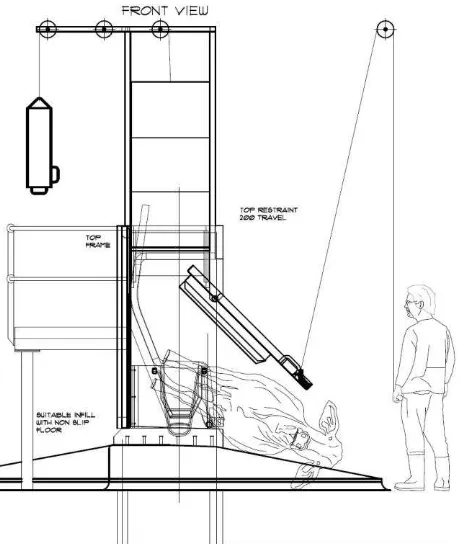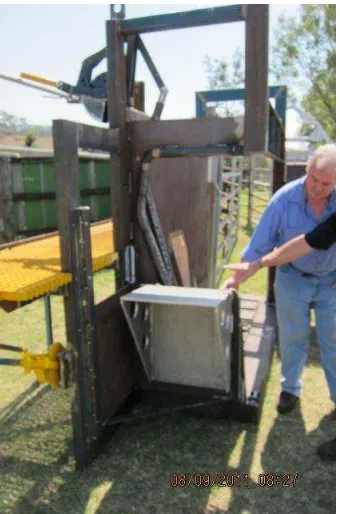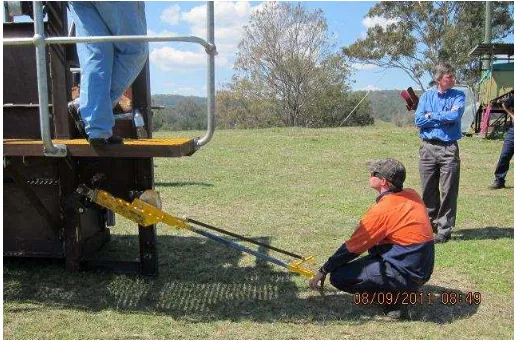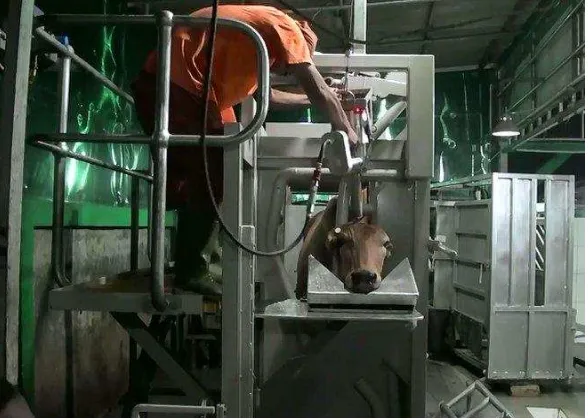Project code: W.LIV.0397 Prepared by: Paul Troja
Felix Domus Pty Ltd Meateng Pty Ltd
G & B Stainless Pty Ltd Date published: October 2013
ISBN: 9781741919721
PUBLISHED BY
Meat & Livestock Australia Limited Locked Bag 991
NORTH SYDNEY NSW 2059
Improving Standing Stun
Restraint in Indonesia
Abstract
Meat and Livestock Australia (MLA) has over many years invested time and money to assist the Indonesian meat and livestock industry improves its handling and eventual processing of
Australian cattle. Specifically MLA had developed and installed several different types of manually and later mechanically operated restraining boxes to assist the abattoir operator in humanely restraining the animal, thus allowing for the appropriate Halal ritual slaughter, which is an essential part of the Islamic religion. Whilst it has been recognised that the Mark 1 restraining box did improve the handling of livestock prior to slaughter compared to the traditional methods, it still had the potential if used incorrectly, to not comply with international animal welfare
The task of retro fitting the Mark 1 restraining box came about as a result of real concerns expressed by the Australian cattle industry in relation to the supply chain issues and humane slaughter of Australian cattle in Indonesia. The specific issue of concern related to the improper use of the Mark 1 restraining box.
The original purpose of this project was to develop, install, and validate to OIE standards;
modifications to the existing Mark 1 restraining box to allow it to be used for either stun or stick of bovine animals in the upright position. This objective was modified after the project commenced so as to align with the Australian industries preferred option of stunning livestock prior to
slaughter. Whilst slaughter without stunning is condoned in the OIE guidelines it is the view of the Australian industry that stunning prior to slaughter represents a more humane and more efficient method of slaughter.
The functionality issues of the restraining box design described in this report, and how they impacted on the operation and time constraints associated with slaughter, are issues that needed to be addressed in the design. There are six elements of functionality that are considered
essential to proper execution of the restraint and stunning box design and operation namely:
1. That the animal’s head be presented in a manner that allows the operator to accurately apply
the stunning device and achieve a near perfect and effective stun every time. 2. That the process allows for the efficient removal of the unconscious animal from the
restraining box apparatus.
3. That the animal be consistently presented for immediate slaughter. 4. That the restraining box be manually operated.
5. That the animal be slaughtered as quickly as possible and within the OIE guidelines. 6. Operator safety.
Prior to installation in an Indonesian abattoir, the restraining box prototype was trialled in
Australia over an eight week period testing the various elements of the design to ensure that the strict criteria as per the OIE guidelines were met. It must be appreciated that the trials were conducted as a capture and release operation, as there was no opportunity to fully test the functionality in terms of a capture and stun.
Following testing, the installation of the restraining box at in Indonesia was successfully
completed by the G&B team. There were no major issues experienced in the installation process which took two days to complete.
It was clear from the very outset that the restraining box application would meet the expectations of the user groups in Indonesia. More particularly the time lapse from head restraint, release, and stick was well within the OIE and AQIS guidelines. The animals release from the head bale and restraining box were, as predicted, with a half roll onto the dry landing platform 300 mm above the floor presenting the animal for the Halal slaughter technique.
stick application, it certainly competes with the non-stun stick in terms of cost of operation and efficiency.
Contents
Page
1
Glossary of Terms ... 6
2
Background ... 7
3
Project Objectives ... 8
4
Results and Discussion ... 9
5
Conclusions ... 17
6
Success
in Achieving Objectives ... 18
7
Impact on the meat and livestock industry
–
now and in 5 years’
time ... 19
8
Recommendations ... 19
9
Bibliography ... 19
1 Glossary of Terms
OIE Office Internationale des Epizooities, World Organisation for Animal Health. AQIS Australian Quarantine Inspection Service.
2 Background
The Australian meat and livestock industry has over many years developed and grown the live export trade based on a strong commercial business case that paid particular respect to the receiving countries cultural and religious beliefs as well as animal welfare practices as expressed in the international codes of practice articulated through the Office International des Epizooties (OIE) and the Australian Quarantine and Inspection Service (AQIS) through appropriate live export licensing standards.
The Indonesian live export market has in a short period of time grown to be Australia’s largest
market driven by a consumer preference for beef protein and a growing Indonesian economy with GDP stable at 6% plus per year. The demand for imported cattle is also supported by the
Indonesian government’s desire to develop its own domestic agricultural capacity using imported
cattle, cheap labour, and feedstuffs available within the country.
In June of 2011 the live cattle export trade from Australia to Indonesia was suspended by the Australian Government because of concerns over the standard of humane slaughter of Australian cattle in Indonesia.
The Australian government reopened the trade to Indonesia under what is now referred to as the Exporters Supply Chain Assurance System (ESCAS). This new regulatory framework requires the exporter to maintain responsibility of Australian cattle whilst in the Indonesian supply chain in accordance with OIE animal welfare guidelines.
3 Project Objectives
During the early stages of the project the objectives changed due to the Australian industries
concern over the live stick application which allows the animal’s throat to be severed whilst the
animal is fully conscious. Whilst this slaughter application of a live stick is condoned in the OIE guidelines it is the view of the Australian industry that this practice of killing a live animal in a conscious state not be perpetuated by this project.
To that end the project objectives became:
1. Design, build and test a retrofit to the existing Mark 1 cattle restraining box to allow it to be used for stunning of bovine animals in an upright position.
2. Reference to and compliance with OIE animal welfare guidelines as described in Chapter 7.5 of slaughter of animals,
3. Documentation, including design fabrication drawings to retrofit components to existing Mark 1 restraining boxes,
4. Use of a full range of stunning equipment including: pneumatic stunning equipment, and hand held non penetrating devices,
5. A manually operated head restraint to allow for a full range of animals and conditions. The program of work was to include:
1. Reconfirm the principles of humane slaughter through past and existing designs, 2. Develop concept and detailed design drawings for the Mark 1 restraining box retrofit
modifications and these be reviewed and approved by MLA and industry representatives from LiveCorp,
3. Fabrication drawings completed and a prototype manufactured in Australia displayed and tested,
4. Ship to Indonesia,
5. Install the retrofit Mark 1 restraining box in a location nominated by MLA, 6. Make modifications to the selected Mark 1 restraining box and raceway,
7. In collaboration with MLA staff conduct a stunning trial and make video and photographic records,
8. Make refinements and re-trial if necessary,
9. In a coordinated manner with MLA provide video footage for Temple Grandin’s review ,
10.Update fabrication drawings to reflect the final working version,
4 Results and Discussion
The approach taken by the team was to firstly define the essential criteria under which the retro fitted Mark 1 restraining box would operate. The criteria definition and categories under which each element of the process was assessed is documented in full in Appendix 1 ‘Essential criteria
for MLA Restraining Box ‘supplied to Indonesia and quite clearly separates design from
operational and site specific issues.
Also as part of the review process the Meateng technical team reviewed the recent history of the Kosher and Halal ritual slaughter restraining boxes around the world to identify various elements of design that could be incorporated into this Indonesian retro fit of the Mark 1 restraining box. The review document concludes that it would be very difficult to do anything with the Mark 1 application as it is basically a catching pen and does little to actually restrain the animal. However the review does develop an alternative to the Mark 1 box which is depicted as an isometric drawing or sketch of a rotating box arrangement that would allow for a stun and or non-stun stick with the animal in the upright position (Figure 1 and 2). Please see Appendix 2 -
‘Development of Restraining Boxes and Halal Slaughter’.
The design of the Mark 1 restraining box was not conducive to easy modification; in fact the only elements of the structure that could be used in fulfilling the above mentioned functionality was the elevated concrete slab and the steel posts that held the back rails and gates in place. Based on these physical parameters a series of preliminary drawings were developed using a
conventional head bale mechanism as the primary device to secure the head and animal within a conventional rectangular box arrangement.
To reduce the cost and to ensure minimal delays in installation it was decided to build a complete restraining box as a prototype (drop in concept) that could later be used to copy and or to modify an existing Mark 1 restraining box using local manufacturing services.
It is quite conceivable that individual operators may choose to use the existing structure of the Mark 1 restraining box and insert a similar head bale arrangement thus achieving the desired outcomes of an accurate and compliant stun. However, it should be noted that the Mark 1 restraining box is by design too wide and too long and will present some operational issues in securing the animal in a timely manner and with minimal stress. It is therefore recommended that whilst it may be cost effective to use the existing Mark 1 infrastructure, consideration should be given to reducing the overall size of the box.
The drawings provided in this report (Appendix 3) give the operator the option to completely retro fit the existing box structure or install a purpose built restraining box that can easily be fitted to the existing concrete slab, cattle raceway, and gate.
The functionality issues of the restraining box and how they impacted on the operation and time constraints are issues that needed to be addressed in the design. There are six elements of functionality that are essential to proper execution of the restraint and stunning operation:
1. That the animal’s head be presented in a manner that allows the operator to accurately apply
the stunning device and achieve a near perfect and effective stun every time, 2. That the process allow for the efficient removal of the unconscious animal from the
restraining box apparatus,
3. That the animal be consistently presented for immediate slaughter, 4. That the restraining box be manually operated,
5. That the animal be slaughtered as quickly as possible and within the OIE guidelines, 6. Operator safety.
To position the forehead and allow the stunning device to strike the head correctly, the head of the animal would have to be raised after the head bale is applied. This action was achieved using a modified head lift similar to that displayed on the Temple Grandin (TG) website. The head lift design eventually adopted was simpler than the (TG) design due to the fact that the process is a stun only application and a manual rather than a power lift operation.
A normal head bale arrangement would allow a live animal to exit the device from the front, in other words the animal could walk through the restraining box after release. In this particular application the animal would be rendered unconscious and unable to move. To overcome this issue of removing the head and animal from the head bale and box, the design allowed for one of the bale pillars to be incorporated into the exit gate structure so that once the gate is opened the unconscious animal could be free to discharge from the head bale and surrounding box
structure.
To enable the animal to roll out of the box an internal metal panel was inserted half way along the box and against the back wall so that when the animal collapsed the protruding metal panel
would force the animal to the door. The animal’s centre of gravity would be towards the door
thus when the door is opened the animal would roll out onto the landing area. To ensure that the animal would roll every time rather than slide a metal rod was fixed to the floor along the exit so
that the animal’s hooves would be secured thus forcing the animal to roll. Originally the exit door
to the restraining box was pivoted and needed a pulley arrangement to slowly open the door thus ensuring a controlled discharge (Figure 1). However, after some discussion this door
arrangement reverted to the existing hinged door. This removed the requirement of extra moving parts are maintained existing infrastructure that local operators were used to.
4.2 Live Animal Trials on Farm Site
There were four separate visits and or trials conducted over an eight week period:
1. Site visit to G & B factory 26th August 2011 - to review the progress to date and gain a firsthand understanding of the functionality of the design.
2. First live trial 16th September 2011 - initial testing of the restraining box revealed issues with the head capture design and bale operation.
3. Second live trail 23rd September 2011 - issues with the head restrain design that identified the need to change the box infrastructure and bale orientation to allow for better stunning access to the forehead of the animal. Further changes to the head lift plate to reduce lateral head movement.
4. Third live trial 6th October 2011 - all six animals were captured and the head restrained to an acceptable standard.
During the design process it was agreed with MLA that the first prototype would be fitted with pneumatic cylinders to operate the head lift and bale mechanisms. The use of air as a power source was contrary to the design brief but agreed to by MLA as a means to accelerate the design and ultimate installation of the restraining box. As can be seen from Figure 3 and 4 below there are two air cylinders in place that could be controlled by the one operator standing on the side mounted platform over the head bale.
After some discussion the project team were asked to revert to the original design brief whereby all mechanical movements had to operate manually.
Figure 4 - Cylinder device in position to operate the head bale. Site visit to G & B Stainless 26 August 2011.
The original door design orientation was not a conventional hinged swinging door but a pivoted door movement. This pivoted door feature was incorporated to allow for a more controlled discharge of the stunned animal from the box. A pivoted door orientation and top and bottom latching mechanism operated well, but the door functionality and latch operation was restrictive in that the operator would be standing in front of the door rather than to one side (Figure 5).
Figure 6 - The hinged door that releases the head bale and allows the animal to exit the restraining box. First live trial16 September 2011.
The Head bale operation successfully captured the animal but the upward motion of the manual lever arm was considered to be undesirable and restricted movement along the work platform. It was converted to a downwards motion.
Figure 8 -Shows the gap between the sub structure of the box and the head bale that allows for vertical head movement. First live trial16 September 2011.
with the head lift plate. However it was evident that the breast plate was not necessary once the non-stun stick element was excluded from the project objectives.
With a simplification of the restraining box functionality the orientation of the head lift mechanism
to the restraining box infrastructure was reversed thus allowing the animal’s head to protrude
further giving better stunning access. At the last trial in October all six animals tested where successfully restrained with the head fixed in one position and presented in a fashion that would provide an accurate and effective stun.
Apart from access and structural adequacy of the existing buildings, the installation of the
restraining box in Indonesia was successfully completed by the G&B team. There were no major issues experienced in the installation process which took two days to complete.
It was clear from the outset that the restraining box application would meet the expectations of the user groups in Indonesia. More particularly the time lapse from head restraint, release, and stick is well within the OIE and DAFF guidelines.
The animals release from the head bale and restraining box were as predicted with a half roll onto the landing platform 300 mm above the floor presenting the animal for the Halal slaughter technique (Figure 12).
Figure 12 – Animal on the dry landing area with the stick application in progress.
4.4 Independent Assessment of Animal Welfare
There was a requirement in the project objectives to have further independent animal welfare assessment of the restraining box design. The assessment will be provided as an addendum to this report upon its completion.
5 Conclusions
The design and construction of a retro type fit out of the existing Mark 1 restraining box has been achieved and fulfilled all of the project objectives as per the revised contractual documents dated the 14th October 2011. All design specifications and drawings are presented in Appendix 3. The project process did reveal several issues in terms of application, and technical outcomes that warrant some discussion.
The modification of the design with retro-fit of additional restraint mechanisms to the original Mark I box is perfectly suited to process bovine animals with live weights of >450 kgs with no compromise to the handling and slaughter process in terms of OIE welfare requirements and ESCAS compliance. The additional restraint mechanisms to the original Mark I box include a head restraint and belly-plate. Further, the success, effectiveness and compliance potential of physically retro-fitting compliant head-restraint and belly-plate devices to any box that reflects Mark 1 box design principles, is dependent upon assurance that the construction and materials used are consistent with and replicate the dimensions and specifications of the original Mark I box.
There are many “copy-cat” type races and restraining boxes in use that are inconsistent with the
dimensions of the original Mark I box and that would be unlikely to produce OIE compliant outcomes if retro-fitted with the head restraint and belly-plate modifications.
The use of the retro type restraining box design is quite flexible and can still be adapted to fit any existing Mark 1 box arrangement provided that the abovementioned issues are addressed. However the cost savings between a retro fit and a new restraining box would be marginal even in Indonesia.
The manual operation of the head bale and head lift has proven to be quite successful due to its simplicity and will require little maintenance provided that they are used correctly. The man power required to use the mechanisms can combine tasks quite easily thus making the tasks of stun and stick very efficient and quick.
For remote abattoir sites with no power supply the head bale restraining box lends itself to a hand held stun gun device.
In viewing the video footage of the restraining box in operation in Indonesia we do note that there are several improvements in design that would further improve this functionality:
1. The head lift device does not engage nor restrain the head of larger and taller animals. This is exasperated on occasions by poor use of the head lift but even so the design could be improved to ensure proper head restraint.
2. The restraining box width should be reduced further to stop smaller animals from reversing and or baulking upon entry to the restraining box.
3. To ensure that the animal will immediately engage with the head restraint the animal must be induced into thinking that there is a way forward.
4. The head lift lever is underpowered for lightly framed operators. 5. The box length is too long, and compromises animal capture.
–
years’
time
The application of this restraining box to the Indonesian domestic environment aims to
encourage the use of stunning. The head bale restraining box is a humane method of capturing and restraining an animal and is superior to the non-stun stick application that persists in
Indonesia and other countries of the world.
The restraining box has multiple applications in all markets that buy Australian cattle given its flexible operation and compliance with ESCAS requirements.
The design allows for a suitable upgrade to the existing infrastructure in Indonesia. However, it should be noted that there are design modifications that could be incorporated into a new
stunning box design that did not need to fulfil the retrofit requirements as outlined in this project.
8
Recommendations
The head bale restraining device design has achieved the desired outcomes of modifying existing infrastructure to allow for humane stunning and slaughter of cattle. The Mark 1
restraining box was not designed to provide a head capture device so it is recommended that a revised design be considered that would further improve the functionality and operator
compliance.
9 Bibliography
10 Appendices
1. Essential Criteria for MLA Restraining Box.






